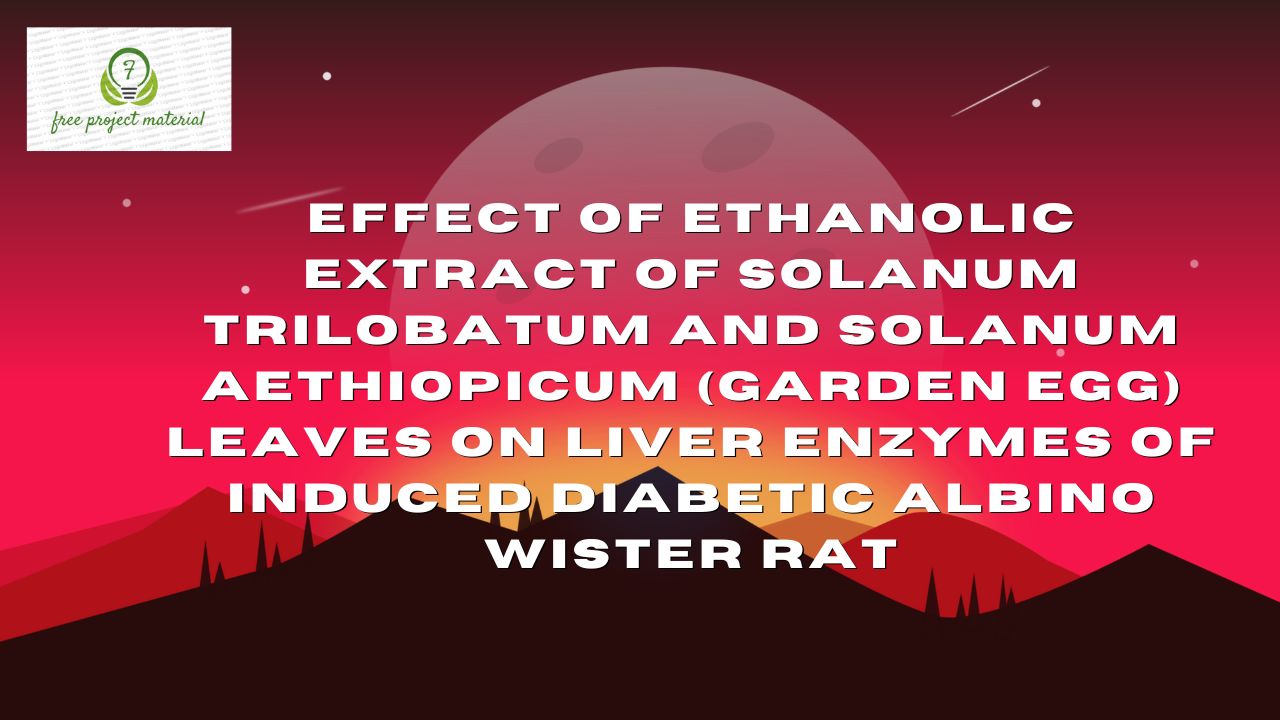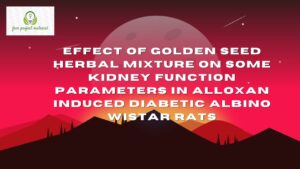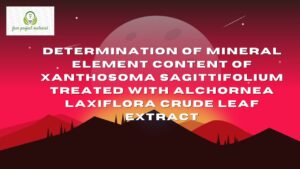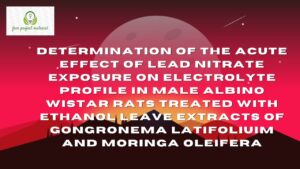ABSTRACT
The aim of this study is to determine the effect of solanum trilobatum and solanum aethiopicum on the liver enzymes of induced diabetic albino wistars. Twenty (20) albino wistar rat were randomly assigned into four groups of five rat each. Group 1 served as the control and was given only the normal rat pellet and distilled water. Group II was given the same treatment as group 1 with alloxan and subsequently treated with metformin, Group iii after inducement with diabetes was treated with leave extract of solanum trilobatum, and Group iv was co-administered with solanum trilobatum and solanum aethiopicucm leaves extract after inducement with diabetes. The result of this study revealed that there was a significant increase (P<0.05) in AST, ALT and ALP in all the treated groups when compared with the control. However among the treatment, metformin group showed the highest ameliorative potential, Also the group treated with only solanum trilobatum showed efficacy when compared with group co-administered with the combined leaves extract. This indicates that solanum trilobatum possess antithyperglycemic and hepatoprotective activity. Therefore, is recommended that normal dose of solanum trilobatum and aethiopicum should be administered in other to avoid toxication.
TABLE OF CONTENTS
Title page- – – – – – – – – – i
Certification- – – – – – – – – ii
Dedication- – – – – – – – – – iii
Acknowledgement- – – – – – – – iv
Abstract- – – – – – – – – – v
Table of contents- – – – – – – – – vi-viii
CHAPTER ONE: INTRODUCTION
1.1 Background of the study- – – – – – – 1-4
1.2 Aim and objectives of study- – – – – – 4-5
1.3 Scope and limitation of the study- – – – – 5
CHAPTER TWO: LITERATURE REVIEW
2.1 Scientific classification of solanum trilobatum- – – 6
2.2 Description of the Solanum trilobatum- – – – 6-7
2.3 Traditional uses of solanum trilobatum- – – – 7-8
2.4 Phytochemical constituents of solanum trilobatum- – – 8-9
2.5 Pharmacological properties of solanum trilobatum- – – 9-13
2.6 Herbal Remedy of diabetes- – – – – – 13-14
2.7 Solanum aethiopicium- – – – – – – 14-15
2.8 Antidiabetic compounds reported from medicinal plant- 15-17
2.9 Toxicity of medicinal plants and polyherbal mixtures use in the management of diabetes.- – – – – – – 17-18
2.10 Clinical significance of liver enzymes- – – – 18-19
2.10.1 Aspartate Aminotransferase (AST)- – – – 20
2.10.2 Alanine Aminotransferases (ALT)- – – – – 20-21
2.10.3 Alkaline Phosphate (ALP)- – – – – – 21
2.10.4 Bilirubin- – – – – – – – – 22
2.10.5 Albumin- – – – – – – – – 22-23
2.10.6 Gamma-glutamyl Transferase (GGT)- – – – 23
CHAPTER THREE: MATERIALS AND METHOD
3.1. Materials- – – – – – – – – 24
3.1.1 Chemicals used/ make – – – – – – – 24
3.1.2 Preparation of reagent used- – – – – – 25
3.1.3 Equipment used/ model – – – – – – – 26
3.2 Method- – – – – – – — – 26
3.2.1 Sample collection and preparation- – – – – 26
3.2.2 Experimental Design and treatment- – – – – 26-28
3.3 Data Collection and analyses- – – – – – 28
3.4 Analytical Procedures- – – – – – – 28-31
3.5 Statistical Analysis – – – – – – – – 31-32
CHAPTER FOUR: RESULT AND DISCUSSION
4.1 Result- – – – – – – – – 33-34
4.2 Discussion- – – – – – – – – 34-37
CHAPTER FIVE: CONCLUSION AND RECOMMENDATION
5.1 Conclusion- – – – – – – – – 37-38
5.2 Recommendations- – – – – – – 38
References
INTRODUCTION
1.1 Background of Study
Medicinal plant can serve as a source of novel therapeutic agent clue to the presences of divers bio active compounds like alkaloids, flavonoids, terpenoids, phenolic compounds, glycosides etc. in plants. They are widely used in the human therapy veterinary, agriculture, scientific research etc plants are playing an important role in the health of millions of people’s life in the work. The world Health organization estimates. Without reliable data, that some 80 percent of the world’s population depend mainly on traditional medicine perhaps some two billion people are largely reliant on mechanical plants. Plants synthesizes hundreds of chemical compounds for functions including defense against insects fungi, disease and herbivorous mammals. (mohanan, 2000). Numerous phytochemicals with potential or established biological activity have been identified. However, since a single plant contain widely diverse phytochemical. The effects of using a whole plant as medicine are uncertain. Further, the phytochemical content and pharmacological actions, if any of many plants having medicinal potential remain unassessed by rigorous scientific research to define efficacy and safely. The increasing worldwide incidence of diabetes mellitus in adults constitutes a global public health burden. It is predicted that by 2030 the world with have a large number of people with diabetes (wild et al., 2004) there are different groups of oral hypoglycemic agent for clinical use having characteristic profiles of side effect (Kamaswara et al., 2004). The solanumtrilobatum (soloanaceas) is a common shrub called as “Tuduvelai” used in various diseases distributed over Gujarat. Deccan, Ceylon, North cereals, Carnatic and malay peninsula (Nadkarni, 2004). The roots and leaves are bitter and prescribed in consumptive cases of acute and chronic bronchitis as thma, cough, and analgesic action (Pandurangan, 2009) the herbs are useful in treating indigestion spermatid hoe, tuberculosis and disease of ear(mohanan, 2000). Solanum trilobatum possess an antibacterial, antifungal anticancer activity antioxidant activity hepatoprtective activity anti-ulcerogenic activity an ant inflammatory activity (Emmanuel et al., 2006). The leaves of the plant possess calcium, iron, phosphorus, fat carbohydrates crude fibre and minerals (Jawhar et al., 2004). Liver an important organ actively involved in metabolic function is a frequent target of number of toxicants in absence of a reliable liver protective drug in the modern medicine there are number of medicinal preparations in the modern medicine there are number of medicinal preparations in Ayurveda recommended for the treatment of liver disorders (Chatterierjee, 2000). The principle causes of carbon tetrachloride (CCL4) induced hepatic damage is lipid peroxidation and decrease activities of antioxidant enzymes and generation of free radicals (Castro et al., 2000).
Diabetes milletus has become devastating health problems nowadays and millions of people are fighting with this dilemma worldwide. Diabetes milletus is an endocrine disease characterized by hyperglycemia which occurs as a result of the in ability of the pancreas to secrete insulin defects in insulin action or both (ADA, 2013). Hyperglycemia results in both microvascular and macrovascular complication which lead to long term failure of various organs (Chawla et al., 2016). Although numerous synthetic antidiuretic drugs are available these medications limitation in their use due to unwanted side effects (Chaudhury et al., 2017) Hence herbal products have been accepting a great demand for the management of diabetes due to low cost high availability and less side effects. Generally diabetes occurs in various form but type I type II and gestational are the dominating ones (Neamsuvan et al., 2015) type I diabetes occurs when beta cells does not produces sufficient amount of insulin it is detected more in children whereas, type II occurs when insulin receptor are unable to use the produced insulin.
1.2 Aim and objectives of the study
Aim
The aim of the study is to determine effect of solanum trilobatum leaves extract on the liver enzymes of induced diabetic albino Wister rat.
Objectives
The objectives of this study is to determine the biochemical effect of solanum trilobatum and solanum aethiopicum extract on albino wistar rats using the following parameters listed below:
- Liver functions markers including:
- Aspartate Aminotransferase (AST)
- Bilirubin
- Albumin
- Alanine aminotransferase (ALT)
- Alkaline phosphate (ALP)
- Gamma- glutamytransferase (GGT)
1.3 Scope and limitation of the study
The research on solanum trilobatum leaves covers it effect on the liver enzymes of induced diabetic albino Wister rat.
However time finance and other factors were limitation of this study.



